
(Matthew 16:13-23)
May these words of this Peter be like a rock,
not a stumbling block!
|
|
"Who do you say
that I am?" Jesus asked. Simon Peter answered, "You
are the Messiah, the Son of the living God." And Jesus
answered, "Blessed are you, Simon son of Jonah! ... You are
Peter (petros), and on this rock (petra)
I will build my church..." Jesus then began to speak of
the rough road ahead. And Peter took him aside and rebuked him... "Get
behind me, Satan!" Jesus replied. "You are a stumbling
block..." (Matthew 16:13-23) May these words of this Peter be like a rock, |
Fragile, living stones
- a "Passion" series based upon 1 Peter 2:4-10Message preached April 11,
2004
Long Green Valley Church of the Brethren
Glen Arm, Maryland USA
based upon Luke
24:1-12
Fourteen
years ago, soon after we moved to Long Green, Maurice Brown gave me a stone. He
and Jane had been to Germany the previous Winter and had visited the infamous
and, by then, no longer effective, Berlin wall. This barrier once 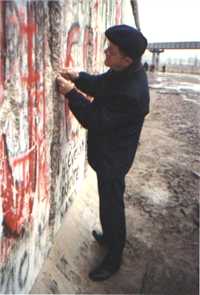 divided
a people between east and west, and stood as a stark reminder of the Cold War.
By the time the Browns stopped by, however, it was just a hunk of concrete, and
Maurice
divided
a people between east and west, and stood as a stark reminder of the Cold War.
By the time the Browns stopped by, however, it was just a hunk of concrete, and
Maurice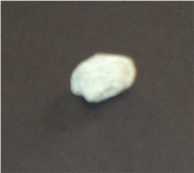 chipped off pieces of it to share with friends. He blessed me with one, along
with a picture of him doing the job, dated "Dec. 5, 1989."
chipped off pieces of it to share with friends. He blessed me with one, along
with a picture of him doing the job, dated "Dec. 5, 1989."
I still
have that stone. I keep it as a reminder that walls can come tumbling down, that
stones intended to hold people in (or keep folks out) arenít necessarily as
permanent as those who put them in place believe. Another example in my lifetime
was the rock called Apartheid. I still posses full page ads I cut out
from the newspaper with which the nation of South Africa tried to fool the world
that one of their bantustans - a gerrymandered geographical space in which
colored people were segregated - was really a brand new republic.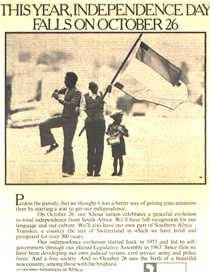
A hot-blooded college student at the time, I was not fooled by this propaganda. I donít think many in our own nation were, even though it played on our sense of patriotism, comparing the Republic of Transkei to the thirteen colonies which won their independence 200 years previously. A picture on one portrayed a young black man playing a fife, a little boy with a drum, and an old man in the middle holding their flag. It was that crass.
I recall debating with my father about how the scourge of Apartheid, which these ads tried to hide, might one day come to an end. I, the radical pacifist, was sure there would be a huge race war that would engulf the southern portion of Africa. My Dad, a bit more hopeful, thought other peaceful possibilities might win out. You know what? He was right. I like telling my own kids this story, for it shows that sometimes dear old dad knows a few things. Through the work of persons like Nelson Mandela and Desmond Tutu, the wall of apartheid came tumbling down. I donít, however, have a stone from that rock to remind me - just a folder of newspaper clippings.
I need this stone from the Berlin wall and this South Africa folder as I look at some other present day walls, literal and figurative. To be honest, I canít see the path through the conflict between Jews and Palestinians in modern day Israel, which involves another very literal wall between east and west bank. Likewise, the battle with terrorism seems so imposing a wall I canít see around it. Can you? Itís the new "Cold War" (which is really very, very "hot"), the old "devil" communism forgotten in the last fourteen years. As I said, though, I need these other stones to remind me that walls can come tumbling down, that stones intended to hold people in or out (or kill them!) arenít necessarily as permanent as those who put them in place believe.
From this very special day of celebration we remember that God is God, and that even the barrier called "death" is not a wall which cannot come tumbling down. There is no stone which can hold in Godís anointed One. God rolled away that rock and Jesus rose from the grave. This belief lies at the heart of our faith. Yes, we often forget this, and focus so intently on how solid and unmovable the stones are which litter the landscape of our lives. We mouth the words of our resurrection faith, but deep down we believe itís really all just a bunch of letters on a page. We live as if God isnít God, that walls are permanent, that injustice is just the way things are, that we really canít do anything about our personal problems, that dysfunctional family patterns are etched in stone and therefore canít be changed, that one person canít really do anything to make a difference.
We forget that one person did make a difference - the one who simply called himself the Son of Man. He taught a new way of living, peacefully fought to bring forth Godís kingdom, and bought our freedom from sin and death upon the cross. On this day we rejoice that God brought him out of the tomb, removing that stone which represents every seemingly unmovable barrier to the good news.
Through the past six Sundays leading up to this moment, we explored some of the "stones" which get in our way. We used actual "stones" to represent these barriers to real life. No need to go over them yet again. It wasnít meant to be an exhaustive list. There are, no doubt, many other figurative "stones" we could have added. Last week, however, we let go of those stones, actually bringing forward and "releasing" them during the final hymn. Well, Iím not foolish enough to believe that all of us did so. One bright young girl came up to me later and asked if it was okay if she had kept hers, and I said, "thatís fine!" Furthermore, Iím sure many of us just went through the motions - maybe not really getting into what was going on, but wanting to join in anyway - for whatever reason. And I say, "thatís okay," also. What speaks to one person doesnít necessarily speak to all.
The point
of it all, however, was to recognize something about that stone which was rolled
in front of Jesusí tomb long ago. Now, you and I know that it was just a rock.
The burial practice back then was to dig a small cave into the side of a hill, 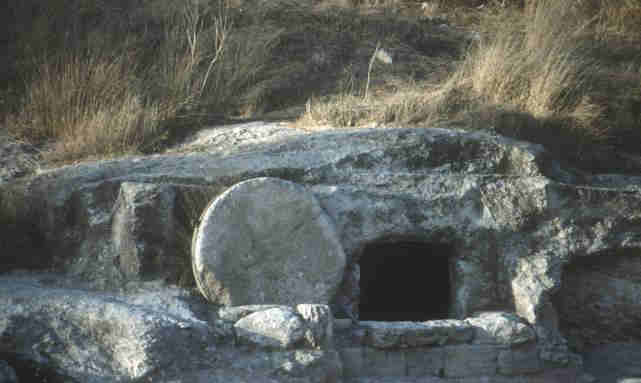 with
an entrance just big enough for a person to bend over, squeeze in, and place the
body of someone who had died. To keep out grave robbers and, no doubt, to keep
in some of the stench of decaying flesh, a heavy boulder was rolled in place to
cover the entrance. From the story as we have received it, at least according to
Matthewís account, came the added element of Roman soldiers guarding the tomb
in which Jesus was laid. Somebody wanted to make sure that rock would stay in
place - just like every stone barrier in every age.
with
an entrance just big enough for a person to bend over, squeeze in, and place the
body of someone who had died. To keep out grave robbers and, no doubt, to keep
in some of the stench of decaying flesh, a heavy boulder was rolled in place to
cover the entrance. From the story as we have received it, at least according to
Matthewís account, came the added element of Roman soldiers guarding the tomb
in which Jesus was laid. Somebody wanted to make sure that rock would stay in
place - just like every stone barrier in every age.
You know
the story. No soldier can stand in the way of resurrection. No stone is too
heavy that it cannot be moved. On the third day God moved it, and the good news
burst from the grave. That was then. This is now. Do you believe that God still
moves stones? Do you believe that walls constructed to divide and conquer (or at
least keep folks in or out), like the Berlin wall or the wall between Israeli
and Palestinian, like apartheid or terrorism; do you believe such walls can come
down, stone by stone? On a more personal scale, do you believe that God can roll
away the stones that litter the la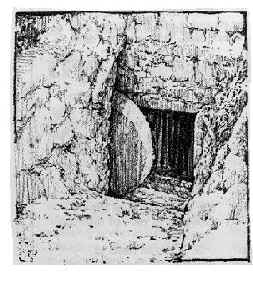 ndscape
of your life, that the barriers which prevent you from living the life God has
in store for you can come tumbling down?
ndscape
of your life, that the barriers which prevent you from living the life God has
in store for you can come tumbling down?
Easter is the almost too-good-to-be-true celebration that in Christ such things are possible. We are resurrection people. We are Easter people. Even when we canít quite imagine how or when "stones" can be rolled away, we believe that they will. And, deep down, we know that because one man - the Son of Man - made a difference, so can we. That belief shifts everything. To say, as it does in 1 Peter, that in Christ we become "living stones," is to mean that we are not dominated by our problems. We are not part of the problem, if you will. We become part of Godís solution. Furthermore, in Christ we are fully alive. And even when we die, no stone can hold us in the grave.
Last week
we let go of our figurative "heart of stone." This week I want you to
take with you a stone which now represents something altogether different. As I
said at the beginning, I still have that stone from the Berlin wall given to me
by my friend Maurice. It reminds me that no wall is too firmly  in
place that it cannot come down. Well, let this stone remind you of the boulder
that was rolled in front of Jesusí tomb. No stone is too heavy that God cannot
move it. Remember that whenever you touch it. Remember also that, in Christ, you
are a "living stone."
in
place that it cannot come down. Well, let this stone remind you of the boulder
that was rolled in front of Jesusí tomb. No stone is too heavy that God cannot
move it. Remember that whenever you touch it. Remember also that, in Christ, you
are a "living stone."
While I sing a song about "Living Stones," the deacons will be passing baskets around. You are welcome to take home a stone of reminder. The refrain to this song is on an insert in your bulletin. Feel free to join me in singing as the baskets are passed.
Living
Stones
I Peter 2:4ff
Chorus:
Living
stones, living stones, we are holy, living stones,
built
upon the firm foundation that is Jesus.
And
as we cling to that Rock who became a stumbling block
we
remember we are living stones
1.
See, in Zion He is known, a chosen precious cornerstone.
And the ones who come to trust in Him will never know the shame
that He bore on that Cross when it seemed that all was lost.
Heís a Stone that makes men stumble, the Rock that makes them
fall.
(Chorus)
2.
By the Word of his mouth we are made one holy house.
Though we live as scattered strangers, we are not homeless, we are
free.
We are one family, one fold, one Overseer of our souls;
Says we are His own possession, we are living stones.
(Chorus)
Written by Michael
Card
© 2002 Mole End Music (ASCAP)
clips of this song can be heard at grassrootsmusic.com
and artistdirect.com
These words are for learning only (the song is copyrighted).
Commit the tune & words to memory, then sing from the heart.
Be thankful for the musician's gift, and bless the Lord.
Just now, I extend an invitation to you. If you have not given your life to Christ, Easter is a good time to make that step. This is resurrection day. The stone has been rolled away. In Christ we become fully alive. Baptism is an outward symbol of an inner transformation, and the water awaits those who want to be a Christian, who are ready to take up the work of Jesus, and to become - if you will - "living stones." Youíll notice that some deacons are standing before you just now. While we sing our final medley of hymns ("God sent his Son," "Amazing Grace!" (vs.1-3), and "Lord, I lift your name on high"), if God is rolling your stone, nudging you to follow Jesus, and you want to respond, "Iím ready, Lord," come forward to one of the deacons and say so. Now is your time. Likewise, if your path has of late been leading you away from the Lord, and you desire on this special day to rededicate your life to Christ, you are welcome to come forth as well.
As it says in scripture, "Come to him, a living stone, though rejected by mortals yet chosen and precious in God's sight, and like living stones, let yourselves be built into a spiritual house, to be a holy priesthood, to offer spiritual sacrifices acceptable to God through Jesus Christ." (1 Peter 2:4-5)
| online resources for this scripture text |
For commentaries consulted, see Luke. |
©2004 Peter
L. Haynes
(you are welcome to borrow and, where / as appropriate, note
the source - myself or those from whom I have knowingly borrowed.)